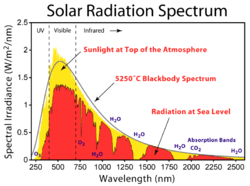Artificial sunlight
Artificial sunlight is the use of a light source to simulate sunlight where the unique characteristics of sunlight are needed, but where sufficient natural sunlight is unavailable or infeasible. A device used to simulate sunlight is a solar simulator.

Composition of natural sunlight

The spectrum of electromagnetic radiation striking the Earth's atmosphere is 100 to 1,000,000 nanometers (nm). This can be divided into five regions in increasing order of wavelengths:[1]
- Ultraviolet C (UVC) range: 100–290 nm
- Ultraviolet B (UVB) range: 290–320 nm
- Ultraviolet A (UVA) range: 320–400 nm
- Visible range or light: 400–700 nm
- Infrared range. It is further divided into three types on the basis of wavelength:
- Infrared-A: 700–1,400 nm
- Infrared-B: 1,400–3,000 nm
- Infrared-C: 3,000–1,000,000 nm
Applications
Illumination
It has been claimed that artificial light sources that provide the light of the closest possible spectrum as provided by the Sun have beneficial effects on health and productivity. This technology is known as full-spectrum lighting.[2]
Light therapy
Artificial sunlight is found useful in treating and preventing Seasonal affective disorder (also known as winter depression, which brings about depressive symptoms specifically in winter),[3] and Delayed sleep phase syndrome, in which the circadian (day V/s night)-rhythm is disturbed, and the individual tends to fall asleep much later than they would desire.
Artificial sunlight may also be useful in prevention, or minimizing the severity of jet lag.[4]
Aquarium lighting
Different corals in a reef aquarium require different lighting conditions. Most of the corals are symbiotically dependent upon zooxanthellae—a type of algae. It is the zooxanthellae that require light to perform photosynthesis, and they provide the coral polyps with simple carbohydrates. In addition to the above techniques of lighting, a new technique employs light emitting diodes (LEDs). The advantage of this technology is that the various parameters of lighting such as warmth and coolness of color are microprocessor-controlled that make it possible to simulate daybreak, sunset, and even the various phases of moon. However, this technology is relatively expensive. Also, some animals like the Red-eared slider turtle benefit from having those lights fitted on their aquariums.
Product testing
Testing the efficacy of sunscreens requires the use of solar simulators.[5]
Manufacturers of solar cells must test the overall efficiency of the cells. They require to be tested indoors, which has traditionally been performed using mostly Sulphur plasma lamps or xenon arc lamp.[6]
Within the automotive industry, solar simulation tests are used to ensure automotive system reliability and functionality.[7]
Artificial sunlight (solar simulators) are also used for sun light exposure testing and of color fastness and material stability for textile, plastics and paints.[5]
References
- Naylor, Mark; Kevin C. Farmer (1995). "Sun damage and prevention". Electronic Textbook of Dermatology. The Internet Dermatology Society. Archived from the original on 5 July 2008. Retrieved 2008-06-02.
- "Full-Spectrum Light Sources". National Lighting Product Information Program. Rensselaer Polytechnic Institute. March 2005. Retrieved 2008-06-05.
- "Light Impacts". Science News. Retrieved 2008-06-05.
- "Kiss jet lag goodbye". www.news.com.au. 2006-03-12. Retrieved 2008-06-05.
- "Solar simulation systems". Photo Emission Tech. Retrieved 2008-06-05.
- J.C., Bisaillon; Cummings, J.R.; Culik, J.S.; Lesko, J.D.; Sims, P.E.; Rand, J.A. (2000). Non-traditional light sources for solar cell and module testing. Photovoltaic Specialists Conference, 2000. Conference Record of the Twenty-Eighth IEEE. IEEE. pp. 1498–1501. doi:10.1109/PVSC.2000.916178.
- "Solar Simulation: Basic Requirements". Archived from the original on 2009-10-10. Retrieved 2010-02-09.